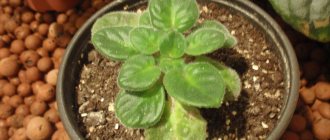One day, in the Uzambara Mountains, Baron Saint-Paul Iller discovered a lovely plant with velvety leaves, strewn with bright flowers. This is how one of nature’s favorite and popular creations appeared to the world - Saintpaulia, Usambara violet or indoor violet. All these are names of the same plant, which is valued for the beauty of its leaves, flowers and duration of flowering. They also love it because the small size of the pots with violets easily fits on narrow window sills and allows them to decorate any room.
Briefly about care
Temperature: +20º – +22º Humidity: up to 70%
Lighting: bright, diffused, up to 14 hours a day Where to put: window sill with eastern, western or northern exposure
Watering: in summer and winter - as the soil dries out Soil: slightly acidic, breathable
Feeding and fertilizing: throughout the entire season, once every 14 days, alternating fertilizers for flowering and decorative foliage plants. Replanting: young plants - 2 times a year, adults - 1 time a year. Reproduction: leaves, separation of “children”
How to properly care for winter?
During the cold season, the main care procedures are as follows::
- High-quality lighting with fluorescent lamps alternates with absolute peace at night.
- The air temperature should not fall below twenty degrees.
- We do not allow drafts.
- We water twice a week.
- All methods of increasing humidity are welcome: water containers, radiator-powered towels and professional devices.
- Leaves should not touch the window: it is too cold now. It is better to put the violets on separate shelves now.
What to do immediately after purchase
Having brought the violet home, spray it with Fitoverm to prevent parasites from infesting: 2 ml of the drug is diluted in 1 liter of water and the leaves are generously sprayed from the outside and inside.
An adult plant should be replanted no earlier than a month later: during this time it will have time to get comfortable in your home. Read further in the article on how to transplant a violet into a new pot.
Important: avoid buying violet seeds: in this way it is almost impossible to repeat the variety you like, and this is also what scammers do.
Place the plant on a bright windowsill. Provide it with diffuse lighting and do not place it in direct sunlight. Periodically, the violet can be turned a little so that it grows evenly.
Hygiene
In any room, even if there is an air purifier, it contains the smallest fractions - dust.
It also settles on the violet leaves, blocking them. If the plant’s “lungs” are heavily polluted, it becomes difficult for it to breathe. Regular cleaning of leaves is one of the conditions for proper plant care. How to do? The pot is placed in a basin (it is better to place it in the bathroom), and the violet is sprayed from a “flower” spray bottle (not in short supply and costs no more than 100 rubles) or washed from the shower head with warm water. Naturally, the pressure is minimal, so as not to damage the leaves and delicate stems.
What to take into account - the water must evaporate naturally. Under no circumstances should you wipe the leaves! And only after they have completely dried can the flower be transferred to the windowsill (the risk of burns has already been mentioned).
Nuances of violet (Saintpaulia) care
This is a slightly whimsical plant, but by following simple rules of care, you can achieve abundant and beautiful flowering from it. Let's talk about how to care for violets.
How long does a violet bloom?
Up to 10 months. With variable abundance. It is important to give the plant a rest for at least a couple of months, for which purpose during the flowering period we tear off the faded buds and flower stalks. More details later in the article.
Temperature
It should be uniform all year round: +20º - +22º. When it is hot, above +28º, turn on the air conditioner or fan, but make sure that the air currents are not directed towards the violet.
You can also place Saintpaulia on the floor during this period: this can help avoid overheating. Frozen water bottles will also lower the room temperature.
Spraying
There is no need to do this: water that gets into the middle of the rosette can cause the flower to rot. However, Saintpaulia does not like and reacts poorly to dry air, so it is advisable NOT to place it near a battery.
Important: moisten the air from a spray bottle around the violet, trying not to get on it. And then let it dry. Don't rush to return her to the window or under the lamp. Wet leaves + ultraviolet light = burns.
Also, to increase the humidity in the room, place a saucer of water next to the violet, which, as it evaporates, will create the microclimate it needs, or buy an air humidifier and place it near the plant.
Lighting
Saintpaulia (violet) should not be placed on a south, south-east or south-west window: this will expose it to direct sunlight all day. If there is nowhere else to place the flower, then hang curtains or blinds. You can also cover the window with translucent film. These methods will help to artificially create partial shade in the room.
The violet needs light, so in the evenings, especially in winter, it can be placed under a lamp, providing 14 hours of daylight.
Watering violets (Saintpaulia)
You should avoid getting moisture on the leaves when watering so that the flower does not rot. It is also important not to overdry the soil, but at the same time not to allow water to stagnate in the pot. The soil should always be consistently slightly moist. Improper watering affects the quality and quantity of inflorescences.
Before watering, test the soil with your finger. If the ground is wet, try again in two days.
For irrigation, choose water that has been standing for at least a day at room temperature. You can use boiled or filtered water. Cold water can cause violet roots to rot.
Watering through a tray
This way, water will not get on the foliage, but the flower may not have enough moisture. Therefore, 15-20 minutes after watering, check whether the top layer of soil is well moistened. Excess water from the pan must be drained.
Drip irrigation
To do this, we use a syringe bulb or a watering can with a narrow spout and water the plant along the edge of the pot, slowly turning it around its axis.
Immersion method
The water in the basin needs to sit for about a day. Then we place the flowerpot with Saintpaulia there and leave it there for an hour. This method works best during periods of extreme heat. It will allow the flower to rest and receive the necessary moisture. Before returning the Saintpaulia to its place, make sure that excess water has drained through the drainage holes.
Watering with a wick
Take a strip of fabric that is highly permeable to moisture. It is advisable to choose synthetic rather than cotton material for this, so that it does not rot or decompose.
The strip is threaded through the drainage hole and passed through the entire pot. The tail of the fabric should remain in the tray. Next, the pot is covered with earth. We pour water into the pan, and the wet wick provides moisture to the entire plant.
To increase the acidity of the water, once a month the water can be watered with acidified acetic (1 tsp per 1 l) or citric (5 crystals per 1 l) acid.
Selecting the substrate
Prefers slightly acidic soil with a pH value of 5.5-6. In an environment that is too acidic or too alkaline, the violet will grow slowly, unopened buds will fall off, and this will also affect the beauty of the foliage. It is difficult to choose suitable soil on your own, so it is better to give preference to ready-made store-bought mixtures.
When preparing the soil yourself, mix the soil with crushed sphagnum and perlite in a 1:1:1 ratio. The substrate will be slightly sour and breathable.
Checking acidity
There is a special device for this. But you can do without it. To do this you need to take two lumps of earth. Add vinegar to the first one: in an alkaline environment it will hiss. Sprinkle another lump with soda: if bubbles appear, the medium is acidic. Otherwise the soil is neutral.
Life hack: dolomite flour reduces acidity, and peat increases it.
Feeding and fertilizer
It reacts favorably to any fertilizing; it is advisable to fertilize it during the entire flowering period of the violet. Even in winter, if it gives color. Alternate fertilizing for flowering plants with fertilizers for decorative foliage plants. Do not increase the dosage indicated on the label to avoid mistakes.
The plant accepts fertilizers containing vitamins B1, B6 and B12 well. Buy Neurobion at the pharmacy and dilute 1 ampoule in 1 liter of water. You can fertilize in two ways: spray the air around the violet so that nutrients settle on the foliage, or feed the soil.
Special fertilizers for violets are also suitable, for example, Agricola (diluted according to instructions).
We fertilize once every two weeks while Saintpaulia is actively growing and giving color. If the temperature rises above +28º, it is better to refrain from feeding, as the plant experiences stress and may react inadequately to feeding, which will affect the leaves and flowers.
After transplanting the plant, you can start fertilizing it in two to six months.
Important: you can fertilize the soil only when it is wet.
Transfer
The plant may begin to bloom worse if one pot is occupied by several rosettes. Plant them in different pots. If the diameter of the rosette has become three times larger than the diameter of the pot, it is also time to look for a new pot.
Important: at temperatures above +28º it is better not to replant the plant: it is already under stress.
Transshipment method
Suitable for young Saintpaulias.
- We take the plant out of the pot along with the substrate.
- We tear off the bottom layer of leaves.
- Choose a pot of larger diameter with drainage holes.
- We plant the violet in a new pot, adding fresh soil.
- We water the transplanted Saintpaulia no sooner than every other day.
Important: if the violet has bloomed, you need to either let it bloom, or remove the inflorescence and only then replant it.
Replanting with soil replacement
Suitable for an adult plant that does not need to change the pot: it is enough to completely or partially replace the soil with fresh soil.
- Remove the violet from the pot.
- We wash and disinfect the pot with any detergent without aggressive surfactants (SLS, SLES), and then rinse it thoroughly.
- Place fresh soil in the center.
- We clean the roots from the substrate and inspect for damage.
- We remove the rotten roots and sprinkle these places with activated carbon, crushed into powder, after which we immerse it in a solution of Fitosporin for 3-4 hours (½ tsp per 100 ml of water).
- Cover the plant with soil.
- It is advisable not to expose the plant to the sun or water it during the day.
It is best to replant violets in the spring, when they do not bloom and do not grow green mass of leaves.
Hygiene of violets
Saintpaulia leaves need to be kept clean. You can brush away dust with a clean brush, for example, an unnecessary blush brush. You should not use sponges or brushes to avoid damaging the plant.
You can also rinse the leaves in warm water. The main thing is to make sure that it does not fall into the center of the rosette, and after the procedure, dry the leaves well before returning it to the windowsill. Otherwise, sunburn may occur.
Rejuvenation
Saintpaulia needs to be rejuvenated four years after planting. To do this, the top is removed, leaving a stalk 2 cm long. After some time, children appear on it, which can later be planted to propagate the flower. The broken off tip can also be rooted to form a new plant.
Trimming
To improve appearance, rejuvenate, stimulate flowering, or if diseased leaves appear, Saintpaulia is pruned. Violet leaves usually grow in three rows.
Removing leaves to stimulate flowering
If the plant begins to produce a lot of succulent leaves, you need to remove the bottom row of leaves so that Saintpaulia does not spend all its energy feeding them. This procedure will help improve the quality of flowering.
Rest period
It occurs in violets after flowering has ended. When it ends, trim off the old dry leaves, those that have turned yellow and withered.
The bottom row can be completely removed, and Saintpaulia can also be replanted. If you do not plan to replant the flower, you can start fertilizing it so that it grows fresh leaves. It is also recommended to reduce watering during the dormant period.
Is it necessary to remove fading violet flowers?
Yes, they can be removed. Just carefully pinch them off or remove them with scissors. If there are still unblown or flowering buds on the peduncle, then it does not matter how long the remaining cuttings are.
Thanks to this manipulation, the plant will look presentable, plus it will not have to waste energy maintaining faded flowers.
How to remove a faded peduncle from a violet
If all the buds on the peduncle have faded, you can completely remove it. It is better to break off the peduncle to the very root, as far as the leaves allow.
Ideally, you need to remove it so that there is no stump left. It's more aesthetically pleasing. Plus, the remaining stump may rot and fungus will appear on it.
But you don’t have to remove the peduncle. Nothing bad will happen.
If you don't touch it, it will calmly finish its life cycle and dry up. You can delete it at any time convenient for you.
If your violet has enough moisture, sun and nutrition, it will calmly continue to bloom.
Care during the cold season
Maintain a stable temperature, do not place on cold, drafty window sills or near radiators, avoid drafts. Make sure that the temperature is not lower than +18º.
Place the pot on a stand, otherwise the roots may freeze. Water with warm water and less often than in summer - do not overwater Saintpaulia.
Ideally, in the evenings, place the violet under a phytolamp. But this is desirable, not mandatory.
Bloom
Violets are one of the beautiful flowering indoor flowers and are grown for their wonderful blooms.
Violets bloom profusely and grow well if you use ion exchange culture or hydroponics under artificial light. Sufficiently bright lighting regulates the active flowering phase. Saintpaulia will begin to produce many new flowers.
It should be remembered that plants quickly become depleted during endless flowering. They need 8 weeks of rest in a dark place.
Abundant flowering usually begins in the second year of violet growth and development.
How to care for violets after flowering
Proper care at home for the Uzambara violet after flowering is to replant it. Some tips on how to do this:
- break off all the lower leaves and dry flower stalks;
- remove the violet from the pot and separate the stepsons for rooting;
- trim the lower part of the root by 1.5 - 2 cm;
- if you intend to use the old pots, then wash them from salt deposits without detergents;
- fill half the container with soil and immerse the exposed rosette trunks into it as deeply as possible;
- add fresh soil on top of the pots without compacting them;
- Water a little, the soil will settle a little and you can add new soil.
The violet planted in this way should be placed in a place with gentle, shaded lighting. Water carefully and moderately - do not overwater, do not overdry.
Typically, caring for violets after flowering does not cause problems if you follow all the recommendations exactly.
Violet propagation
Violet can be propagated in a variety of ways, and all work equally well. Children germinate quickly, and soon you will be the proud owner of an adult Saintpaulia.
Rooting cuttings in soil
To avoid rotting, first dry the freshly broken leaf. Half an hour is enough.
After this, take a plastic cup, make holes in the bottom and fill it halfway with prepared soil.
We root the leaf shallowly: 1-1.5 cm. We prepare a greenhouse from a zip bag or a regular cellophane bag. Place in a warm, wind-free place away from direct sunlight. The cuttings need to be watered the day after planting.
In one and a half to two months, children will grow from the cuttings, which can be planted in separate pots. The shoots are approximately 5 cm in height and with three pairs of leaves, ready for spreading.
Rooting cuttings in water
You can also root the leaves in water without planting them directly in the ground. For propagation, you can take a leaf from any row, the main thing is that it is undamaged, green and juicy.
Choose a dark container with a narrow neck, and choose boiled water with the addition of crushed activated carbon (1 tablet per glass of water): this will prevent rotting.
Do not let water get on the leaf. After about 2-4 weeks, the roots will have developed enough that the plant can be planted.
Rooting a leaf fragment
To grow Saintpaulia you don’t necessarily need a whole leaf; a small piece of leaf will do, even if it is damaged.
Important: first remove spoiled and yellowed parts with a disinfected knife. Make sure that the leaf cut runs along the side veins.
You need to cut a petiole from the central part of the fragment and plant it in the ground. You can also skip this procedure and just root part of the leaf in the ground.
After landing, we wait for the children and seat them in pots. It is even possible to use half a leaf or a leaf cut in a circle to get rid of dried fragments.
If the leaf becomes limp and wilted after planting, remove it from the pot and soak it in warm water. Dry before re-rooting.
You can also divide the leaf cross by cross and root each part in the ground
Landing of stepchildren
Stepson (baby) is a fresh rosette growing between the leaves of a violet. They also propagate the plant. Wait until it grows three or four pairs of leaves. Carefully cut it from the violet stem with scissors, plant it in the ground and cover it with a greenhouse.
Reproduction by peduncles
Violets can also be propagated by flower stalks. We choose healthy, beautiful flower stalks with inflorescences of the correct shape, cut them and remove the buds.
We shorten the leg, leaving about 1.5 cm. We plant it in the ground and wait for the stepsons to appear, after which we seat them like ordinary children.
Why does violet (Saintpaulia) not bloom?
Let's look at the main reasons.
Excess or lack of fertilizers
These plants prefer small containers, and the soil is quickly depleted, so there may not be enough nutrition, inflorescences appear.
Overfeeding will ruin the young roots, and the plant will not bloom and may even die. It is recommended to feed once every two weeks and not to change the dose indicated on the label.
Capacity too large
The underground organs of the flower are small, so you should give preference to small flower pots. The diameter of the rosette should not exceed the diameter of the pot by more than three times.
Unsuitable soil
The flowering of Saintpaulia directly depends on the acidity of the soil. If the soil is chosen incorrectly, the buds will crumble without blooming. Choose a light, water- and breathable soil for violets that does not harden or dry out too much.
Spontaneous watering
Violet is sensitive to watering. It is important to moisten it according to a certain scheme and not to overdry the soil. We do not allow overfilling or underfilling.
You cannot water the flower every day; excess moisture is drained from the tray. We choose water at room temperature and avoid getting it on the leaves and in the outlet.
Insufficient lighting
If possible, move the plant to a more illuminated windowsill, or provide additional light with a phytolamp.
After changing the location of the flower, leave it alone for a while: do not water, prune or replant until it gets comfortable in the new place.
Failure to comply with temperature conditions
To ensure that the violet blooms well, do not overcool or overheat it. Temperatures below +14º and above +28º are considered dangerous.
Soil for plants
Special soil for violets is sold in many stores. Violet prefers acidic soils, so the substrate for it is peat. It should be light and absorb moisture well.
Heavy, clayey or waterlogged soil is not suitable for the plant. The soil should not be oversaturated with additives. This will cause leaves to grow quickly but will prevent flowering.
You can prepare the soil for violets yourself. To do this, you need to pour a small amount of sand into the sifted garden soil, and make a drainage layer of expanded clay at the bottom of the container for the plant.
Pests and diseases
A flower rarely gets sick and most often this happens when all indoor plants are massively affected. To remove pests, you can use the drug Aktara, or mix Fitoverm and Bitoxibacillin.
White coating on leaves
Unfortunately, your flower has a fungus - powdery mildew. Favorable conditions for its appearance are drafts and cold (+16º - +17º). If the plant blooms, it is necessary to remove the flowers, and then spray the leaves from the outside and inside with a fungicide with penconazole (dilute Fitosporin ½ tsp per 100 ml of water; Topaz - 1 ampoule per 4 liters of water) several times with an interval of 10-14 days .
To avoid re-infection, move the violet to a warm place, avoid drafts. Also spray the flower monthly with water with potassium permanganate (a faint pink solution) or Fitosporin.
Brown spots on leaves
These are signs of late blight, a fungus that invades damaged parts of the plant that have not healed.
Unfortunately, this is incurable, and the Saintpaulia will have to be burned and the flower pots disinfected: the disease can spread to other indoor flowers.
To avoid infection, make sure that the air humidity is not too high, and when mixing the soil, you can add superphosphate in a proportion of 1 tsp. per liter
Gray fuzzy mold
This symptom is caused by gray rot or botrytis, another fungal disease that affects violets. It is necessary to get rid of the affected parts of the flower and treat the flower with fungicides (Fitosporin in a dosage of 0.5 tsp per 100 ml of water or Topaz - 1 ampoule per 4 liters of liquid).
If the disease develops quickly, the plant will die. Throw it away along with the soil.
To prevent re-infection, avoid sudden temperature changes and try not to flood the flower.
Fusarium or rosette rotting
This is another fungus. Signs: brown leaves, falling leaves, darkening of roots.
It is necessary to cut out all affected areas and treat the soil with Fundazol, 1 g per liter of water.
As a preventative measure, avoid overcooling, flood the plant with especially cold water, and choose a pot that is too large.
Rust
It is expressed in the appearance of rusty-colored pads on the back of the leaves and orange-yellow tubercles on the front. Leaves may begin to fall. The violet must be treated with a one percent Bordeaux mixture or fungicide (Vectra, Topaz).
To prevent the development of fungal diseases, you can spray Saintpaulia with Fundazol once every 2 months.
Violet leaves curl up
Your flower has been attacked by a mite. In addition to curled leaves, some other symptoms may be observed: the green mass stops developing, flowering practically stops, and the flowers that appear have an irregular shape.
Treat with acaricides: Fitoverm is diluted in a dosage of 2 ml per 1 liter of water, Aktofit - 4 ml per 1 liter of water). Wet the leaves generously on both sides. Treatment is carried out four times at intervals of four days. Spraying should be carried out annually.
Sticky discharge on leaves
This is a symptom of the appearance of scale insects or false scale insects. They look like flat brown bumps. Wash off the insects with a swab dipped in a soap solution with the addition of machine oil or kerosene (2-4 drops), then moisten the leaves with Agravertine in a dosage of 5 ml per 2.5 liters of water.
If the buds dry quickly and yellow pollen appears on the petals
Your violet has been attacked by thrips. The flower stalks must be cut off, and the plant itself must be treated with Fitoverm (10 ml per 1 liter of water) or Aktara (1 g per 1 liter of water). A soap solution with 2-4 drops of kerosene will also help get rid of thrips.
Alternatively, you can spray with garlic infusion. To avoid the invasion of these pests, special attention should be paid to indoor air humidity and limit feeding.
Nematodes
These are small worms that infect the roots of the plant. They will be indicated by swellings on the roots, cuttings and veins, resembling beads. Leaves can also be affected. In this case, spots appear on them, which then darken and begin to rot.
Unfortunately, there are no suitable nematode preparations for indoor plants yet; those used in agriculture are too toxic for residential premises. Therefore, it will not be possible to remove the pest, and you need to get rid of Saintpaulia.
However, if you find an untouched leaf, use it to re-root the violet. Just rinse the cut with water and root the leaf.
To NOT infect other plants:
- Do not keep violets in one tray. Each one should have an individual one.
- Maintain good hand hygiene: when you check the soil moisture with your finger before watering, you should not use it to check other pots, as this can easily transfer nematodes.
Violets have a white coating similar to cotton wool
Appears on cuttings and is caused by scale insect parasites. Treat the plant with Fitoverm at a dosage of 10 ml per 1 liter of water. Repeat the procedure 3-4 times every 5 days. You can also use a soap solution with a few drops of machine oil added, or prepare an infusion of calendula, tobacco or garlic.
If you find plaque on the roots when you replant your violet, these are root scale insects. The substrate is watered three times with an interval of 1.5 weeks with Mospilan or Dantop at a dosage of 1 g per 1 liter. After completing the procedures, transplant the plant into a new pot with a complete replacement of the soil; before transplanting, remove the affected roots.
Aphid
They will be indicated by the sticky liquid on the foliage and peduncles, deformed leaves and the insects themselves, which like to be located on the underside of the leaf. Spray the violet with Actellik 2-3 times with a break of one to two weeks.
Woodlice
These are insects up to 15 mm long that destroy foliage and roots. They look like small white armadillos. Treat Saintpaulia and substrate with Actellik or Fitoverm.
Flies and mosquitoes
Their larvae injure the underground organs of the plant and destroy the substrate, which becomes compacted and becomes air- and water-tight. As a result, Saintpaulia rots.
It is necessary to spill the soil with Fufanon (1 ml per 1 liter of water), and treat the edge of the pot with chalk to prevent cockroaches. Adults are destroyed with Dichlorvos or Raid. Do not leave water in the pan or flood the plant.
Springtails (springtails)
These are tiny whitish insects with antennae from 2 mm to 1 cm in length, crawling along the soil. They destroy the roots of the plant. To destroy them, spill the substrate with Pyrethrum (2 g per 1 liter of water). These pests are also attracted to high humidity, so watering should be adjusted.
Whiteflies
They are small white butterflies that can be seen on violets (Saintpaulia). Because of them, the leaves turn white and then turn black, and the stems stop growing.
To get rid of them, it is necessary to treat the plant 2 or more times with an acaricide mixed with an insecticide. To do this, mix Aktara (1 g per 2 liters of water) with Fitoverm (1 g per 2 liters of water) or Mospilan (1 g per 2 liters) with Aplaud (1 g per liter of water).
No flowering
For a plant to bloom, it needs to have well-developed roots, and this is impossible in a pot that is too large. Choose smaller pots, reduce fertilizing and provide good lighting.
Spots on the foliage
Perhaps it's sun exposure. It is enough to move the plant to a less lit place, or provide shading.
Leaves may also turn yellow due to lack of watering, fertilizing and improperly selected soil. The violet needs a transplant.
Light spots on the plant appear due to drafts. At the same time, at first glance it seems that everything is in order with the violet, and its leaves remain juicy. It is impossible to get rid of this scourge, but you can prevent it: when ventilating the room, cover the flower with film or newspaper.
Useful tips
- Taking into account the fact that violet is a light-loving plant, its leaves will intensively stretch towards the window. To make the plant look attractive (and this means symmetrical), the position of the pot must be regularly changed (rotated).
- Yellowed leaves and wilted flowers are removed as they appear.
- In winter, violets should be removed from the windowsill. A low temperature is detrimental to it, so it is better not to take risks and not rely on radiators. You can find recommendations that in cold weather the pot of violets should be covered with glass (transparent) dishes. Perhaps this is an option, but the question arises - what to do with the greenhouse effect? Will the flower suffocate in such a limited and closed volume?
- In the summer, city apartment owners move home flowers to the balcony (loggia), and this is correct and beneficial for plants, but not for violets. The reason has already been indicated - drafts, which she really doesn’t like.
Varieties of violets with photos and names
Blue Dragon
The leaves are hairy and have a serrated edge. The lower tier of leaves is red. The rosette can reach a diameter of 50 cm. It has large double flowers of a dark blue color.
Harry Potter
The leaves are drooping, pale green. The rosette is dense and small. Large soft blue flowers edged with white.
Cupid
The leaves are green and shiny. The rosette is large and wavy. Blooms profusely, double inflorescences are white with a green border.
Breath of the Storm
It has dark green leaves with a wavy edge on a long stalk. Small socket. Large purple flowers with white edges.
Macho
The leaves are ovate, green. The flowers are double, purple-burgundy with a white border.
Jan-whim
The leaves are wavy and pinnate. The inflorescences are white with a green corrugated border.
Water
Wavy leaves of a light green hue. It has dark blue double buds with a green edge. Seawolf The foliage is dark green. Double flowers are blue and very large.
Parisian secrets
The leaves are spotted, white-green. The double lilac flowers have a greenish-white border.
Jabot
The leaves are deep green with a wavy edge. Terry lilac flowers along the edge turn into a green tint.











